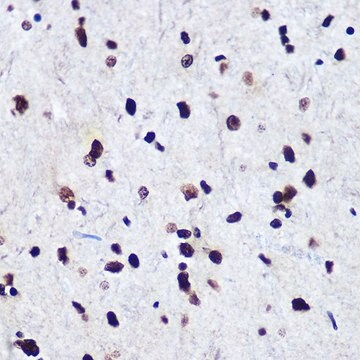350-05A
Human Coronary Artery Smooth Muscle Cells: HCASMC, adult
Sinónimos:
HCASMC cells
About This Item
Productos recomendados
origen biológico
human coronary artery (normal, tunica intima and media)
Nivel de calidad
envase
pkg of 500,000 cells
fabricante / nombre comercial
Cell Applications, Inc
modo de crecimiento
Adherent
cariotipo
2n = 46
morfología
smooth muscle
técnicas
cell culture | mammalian: suitable
enfermedades relevantes
diabetes; stroke; cardiovascular diseases
Condiciones de envío
dry ice
temp. de almacenamiento
−196°C
Descripción general
Human Coronary Artery Smooth Muscle Cells (HCASMC) provide an excellent model system to study all aspects of cardiovascular function and disease, especially those related to mechanisms of hyperplasia and hypertrophy of intimal smooth muscle cells leading to vascular occlusion in atherosclerosis and stent restenosis.
HCASMC has been utilized in a number of research studies, for example, to:
- Study signaling pathways regulating smooth muscle differentiation (Zhou, 2010); and chronic inflammation of arterial wall that leads to artherosclerosis (Kiyan, 2014)
- Demonstrate that STAT-1 and STAT-3 regulate VEGF production in smooth muscle cells by having opposing effects on HIF-1α expression (Albasanz-Puig, 2012); study the mechanisms of hypoxia and reoxigenation injuries in by demonstrating increased production of ROS and inflammatory cytokines, and further showing that DHA is not beneficial in this type of injuries (Feng, 2012)
- Investigate the gene expression differences between smooth muscle cells from different arteries, underlying their differential response to injuries and proliferation stimuli (Lange, 2013)
- Suggest the hypermethylation of SOCS3 gene as the connection between TNF-α and IGF-1 released in response to mechanical injury during coronary intervention, and the induction of cytokines leading to intimal hyperplasia and restenosis (Dhar, 2013)
- Develop a novel VEGFR/MET-targeted inhibitor with improved antitumor efficacy and decreased toxicity (Fujita, 2013); and investigate novel therapies and drug combinations to achieve optimal target selectivity (Lehar, 2009; Wo-Wong, 2013)
- Develop elastic scaffolds for tissue engineering (Nivison-Smith, 2010, 2012) and novel treatment strategies to prevent stent restenosis by designing new materials (Crowder, 2012), or drug therapies to preferentially inhibit smooth muscle cell growth (O’Neill, 2009; Mociornita, 2013)
Characterization: positive for smooth muscle cell specific alpha-actin expression.
Origen línea celular
Aplicación
Componentes
Nota de preparación
- 2nd passage, >500,000 cells in Basal Medium containing 10% FBS & 10% DMSO
- Can be cultured at least 16 doublings
Rutina de subcultivo
Cláusula de descargo de responsabilidad
Código de clase de almacenamiento
11 - Combustible Solids
Clase de riesgo para el agua (WGK)
WGK 3
Punto de inflamabilidad (°F)
Not applicable
Punto de inflamabilidad (°C)
Not applicable
Elija entre una de las versiones más recientes:
Certificados de análisis (COA)
It looks like we've run into a problem, but you can still download Certificates of Analysis from our Documentos section.
Si necesita más asistencia, póngase en contacto con Atención al cliente
¿Ya tiene este producto?
Encuentre la documentación para los productos que ha comprado recientemente en la Biblioteca de documentos.
Artículos
Technical information for working with human coronary artery smooth muscle cells including thawing, subculturing and cryopreservation
Nuestro equipo de científicos tiene experiencia en todas las áreas de investigación: Ciencias de la vida, Ciencia de los materiales, Síntesis química, Cromatografía, Analítica y muchas otras.
Póngase en contacto con el Servicio técnico




